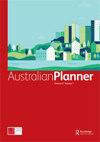Rethinking population shrinkage in the Australian context: a new research agenda
IF 1.5
Q2 Social Sciences
引用次数: 1
Abstract
ABSTRACT Whilst the study on the impact of shrinkage is well documented in North America and Europe, the effects of population-driven shrinkage on rural and regional communities in Australia is comparatively under-researched. This is despite existing literature on the volatility of population change in regional and rural Australia. Therefore, there is cause for establishing a typology of shrinkage in the Australian context, unpacking the different and complex economic, social and environmental causes and consequences, and therefore impacts, and establishing a framework for ongoing research. In this paper, we set out the rationale for this typology, indicating how population drivers are not only extensive, but further complicated by the as-yet-unknown impacts of COVID-19 and teleworking. Regarding policy solutions, we suggest that while mindsets are increasingly changing from a need to reverse population trends to, instead, embracing opportunities and alternative futures for many regional and rural Australian towns, we need to first establish a typology of population shrinkage that is reflective of the Australian context to ensure policy responses are locally appropriate. Practitioner pointers - Mindsets around planning policies on the impacts of population-driven shrinkage are beginning to shift towards understanding the specific socio-economic circumstances of the localised area and adopting appropriate policy instruments accordingly. - To support this nascent shift, establishing a typology of shrinkage that is reflective of the Australian context is key.重新思考澳大利亚背景下的人口萎缩:一项新的研究议程
摘要尽管北美和欧洲对人口萎缩影响的研究已有充分的文献,但澳大利亚对人口萎缩对农村和地区社区的影响的研究相对较少。尽管已有关于澳大利亚地区和农村人口变化波动性的文献,但情况依然如此。因此,有理由在澳大利亚的背景下建立一种收缩类型,揭示不同而复杂的经济、社会和环境原因和后果,从而产生影响,并为正在进行的研究建立一个框架。在这篇论文中,我们阐述了这种类型的基本原理,表明人口驱动因素不仅广泛,而且由于新冠肺炎和远程工作的未知影响而进一步复杂化。关于政策解决方案,我们建议,尽管心态正在从扭转人口趋势的需要日益转变为为为澳大利亚许多地区和农村城镇提供机会和替代未来,但我们需要首先建立一种反映澳大利亚背景的人口萎缩类型,以确保政策应对措施适合当地。从业者指南-围绕人口萎缩影响的规划政策,人们的心态开始转向了解当地的具体社会经济情况,并相应地采取适当的政策工具为了支持这一新生的转变,建立一种反映澳大利亚背景的收缩类型是关键。
本文章由计算机程序翻译,如有差异,请以英文原文为准。
求助全文
约1分钟内获得全文
求助全文

 求助内容:
求助内容: 应助结果提醒方式:
应助结果提醒方式:


